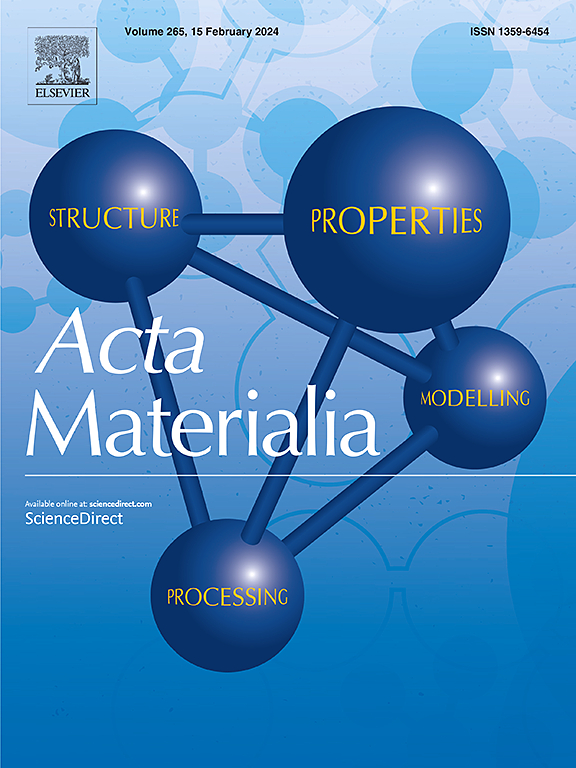基于位错形核机理的高延展性TiAl合金设计
IF 8.3
1区 材料科学
Q1 MATERIALS SCIENCE, MULTIDISCIPLINARY
引用次数: 0
摘要
纳米级双相材料的屈服强度和塑性受位错成核的临界分解剪应力(CRSS)的影响。具有γ-TiAl和α2-Ti3Al交替层的聚合成孪晶(PST) TiAl单晶在室温下具有较高的屈服强度和延展性。然而,其高性能与位错成核机制之间的关系尚不清楚。本文采用分子动力学模拟方法,通过双轴加载研究了γ-TiAl/α2-Ti3Al合金中界面位错和滑移面法向应力对位错形核的影响。在屈服初期观察到三种类型的位错,包括{111}<;112¯]{111}<;112¯]双位错和{111}<;1¯01]{111}<;1¯01]γ-TiAl的超晶格位错,{11¯00}<112¯0>{11¯00}<112¯0>;α2-Ti3Al的棱柱位错。对屈服条件的分析表明,三种滑移体系的分解剪应力和分解正应力之间存在近似的线性关系,这与第一性原理的结果一致。我们提出了一种基于这种关系的高延性TiAl合金设计策略,即通过预应力引入两相CRSS之间的应力差。为了验证该策略在实际应用中的有效性,我们对PST TiAl单晶进行预压缩,引入两相之间的强度差异,导致裂纹均匀发生在γ相,限制在α2相,最终使PST TiAl单晶的伸长率提高了约300%。本文章由计算机程序翻译,如有差异,请以英文原文为准。


Designing high ductility TiAl alloys based on dislocation nucleation mechanism
The yield strength and ductility of nanoscale biphasic materials are governed by the critical resolved shear stress (CRSS) for dislocation nucleation. Polysynthetic twinned (PST) TiAl single crystals with alternating layers of γ-TiAl and α2-Ti3Al exhibit high yield strength and ductility at room temperature. However, the relationship between its high performance and dislocation nucleation mechanism has not been clearly understood. In this work, we investigated the influence of the interfacial dislocations and the normal stress of slip plane on dislocation nucleation in the γ-TiAl/α2-Ti3Al alloys via biaxial loading using molecular dynamics simulations. Three types of dislocations were observed in the initial yielding stage, including twin dislocation and superlattice dislocation for γ-TiAl, prismatic dislocation for α2-Ti3Al. The analysis for the yield conditions revealed that there is an approximate linear relation between the resolved shear stress and resolved normal stress for the three types of slip systems, which is consistent with the results of first principles. We proposed a design strategy for high ductility TiAl alloys based on this relationship, which involves introducing stress differences between the CRSS of two phases through pre-stressing. To verify the effectiveness of this strategy in practical applications, we applied pre-compression to the PST TiAl single crystal to introduce the difference in strength between the two phases, which led to crack uniformly occurring in γ phase but limiting in α2 phase, finally increasing the elongation of PST TiAl single crystal by about 300 %.
求助全文
通过发布文献求助,成功后即可免费获取论文全文。
去求助
来源期刊

Acta Materialia
工程技术-材料科学:综合
CiteScore
16.10
自引率
8.50%
发文量
801
审稿时长
53 days
期刊介绍:
Acta Materialia serves as a platform for publishing full-length, original papers and commissioned overviews that contribute to a profound understanding of the correlation between the processing, structure, and properties of inorganic materials. The journal seeks papers with high impact potential or those that significantly propel the field forward. The scope includes the atomic and molecular arrangements, chemical and electronic structures, and microstructure of materials, focusing on their mechanical or functional behavior across all length scales, including nanostructures.
 求助内容:
求助内容: 应助结果提醒方式:
应助结果提醒方式:


